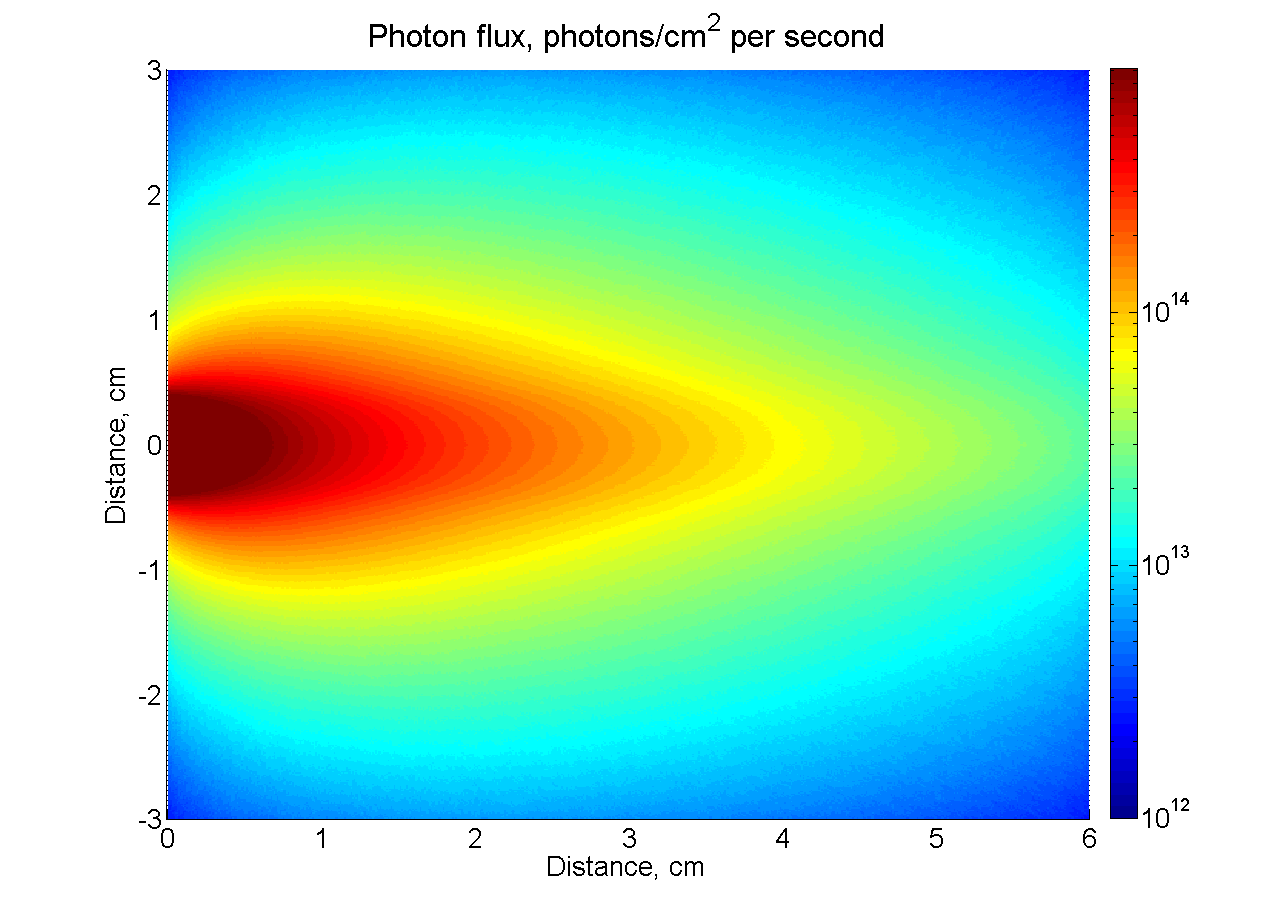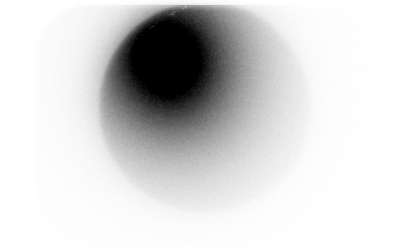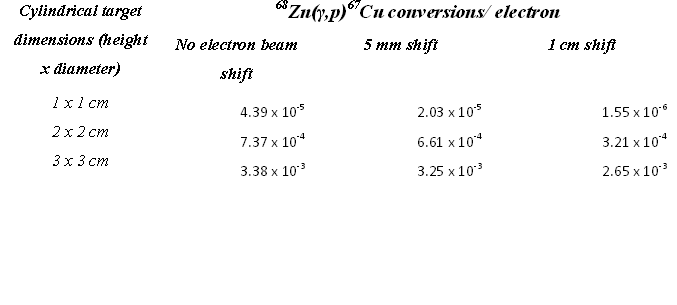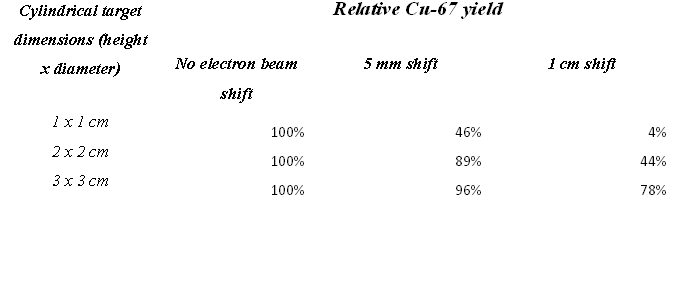Difference between revisions of "TF IsotopeTracers"
| Line 24: | Line 24: | ||
In June of 2012, the Idaho Accelerator Center received a grant from the state of Idaho as part of the Idaho Global Entrepreneurial Mission (IGEM) program. One of the proposed objectives was to research the production of Copper isotopes for use in medical diagnostic procedures. Preliminary results of the work sponsored by this research have indicated that the production of Copper isotopes depends strongly on the photon flux alignment with the target isotope sample. While a sample size of 2 cm may produce the highest number of isotopes per volume, a missalignment of more than a centimeter may result in more than half of what can be achieved. Based on these results, a strong need now exists for a system to monitor the spatial distribution of the photons used to irradiate the samples. Based on the preliminary results of the IGEM supported isotope production research and the Photon Activation Analysis (PAA) work, we propose the developement of an irradiation instrument, that qualifies for the MRI category "Track 2", to be used for isotope production and PAA analysis. | In June of 2012, the Idaho Accelerator Center received a grant from the state of Idaho as part of the Idaho Global Entrepreneurial Mission (IGEM) program. One of the proposed objectives was to research the production of Copper isotopes for use in medical diagnostic procedures. Preliminary results of the work sponsored by this research have indicated that the production of Copper isotopes depends strongly on the photon flux alignment with the target isotope sample. While a sample size of 2 cm may produce the highest number of isotopes per volume, a missalignment of more than a centimeter may result in more than half of what can be achieved. Based on these results, a strong need now exists for a system to monitor the spatial distribution of the photons used to irradiate the samples. Based on the preliminary results of the IGEM supported isotope production research and the Photon Activation Analysis (PAA) work, we propose the developement of an irradiation instrument, that qualifies for the MRI category "Track 2", to be used for isotope production and PAA analysis. | ||
| − | The proposed instrument will | + | The proposed instrument will composed of a photon beam monitoring system and a sample conveyor. Support from this MRI will be used to construct the photon monitoring system. The sample conveyor system, commonly referred to as a rabit, will transfer samples into the irradiation region and then to a shielded container (lead pig) after irradiation. The transportation system is a necessity due to the high activity isotopes that may be produced. When used as a PAA facility, the transportation system will eliminate the step of shutting the machine off in order to change samples. Once calibrated, the photon monitoring system would allow users to irradiate sample with a know amount of radiation. |
==Talking points== | ==Talking points== | ||
Revision as of 01:50, 3 December 2012
MRI RFP
http://www.nsf.gov/pubs/2013/nsf13517/nsf13517.htm
Highlights.
"MRI is not used to buy a suite of insturments to outfit research laboratories/facilities or be used to conduct independent research activities simultaneously".
"MRI is used for a single insturment or when combined serves as an integrated instrument."
The photon flux monitor when combined with the rabbit will be an instrument for both isotope production and PAA analysis research. The tool will have inter-disciplinary uses ranging from engineering to archeology.
- Track1
- Acquisition of a single instrument
- Track2
- development of a single instrument or for equipment that when combined serves as an integrated instrument.
We will be track 2. The combined equipment will be an integrated instrument for the production of Isotopes to be used in research and industry. The devise will also be an instrument for PAA analysis.
Proposal
Purpose
In June of 2012, the Idaho Accelerator Center received a grant from the state of Idaho as part of the Idaho Global Entrepreneurial Mission (IGEM) program. One of the proposed objectives was to research the production of Copper isotopes for use in medical diagnostic procedures. Preliminary results of the work sponsored by this research have indicated that the production of Copper isotopes depends strongly on the photon flux alignment with the target isotope sample. While a sample size of 2 cm may produce the highest number of isotopes per volume, a missalignment of more than a centimeter may result in more than half of what can be achieved. Based on these results, a strong need now exists for a system to monitor the spatial distribution of the photons used to irradiate the samples. Based on the preliminary results of the IGEM supported isotope production research and the Photon Activation Analysis (PAA) work, we propose the developement of an irradiation instrument, that qualifies for the MRI category "Track 2", to be used for isotope production and PAA analysis.
The proposed instrument will composed of a photon beam monitoring system and a sample conveyor. Support from this MRI will be used to construct the photon monitoring system. The sample conveyor system, commonly referred to as a rabit, will transfer samples into the irradiation region and then to a shielded container (lead pig) after irradiation. The transportation system is a necessity due to the high activity isotopes that may be produced. When used as a PAA facility, the transportation system will eliminate the step of shutting the machine off in order to change samples. Once calibrated, the photon monitoring system would allow users to irradiate sample with a know amount of radiation.
Talking points
1.) The accelerator "Jack" is an instrument for PAA and isotope production
2.) Isotope production impact on other areas of research (medical, fracking, underground pipelines, spikants for homeland security)
3.) Inter organizational use of PAA ( Geology, Archeology, certification for coffee origins....)
4.) Impact of Photon Flux monitoring for PAA analysis
5.) Device will train accelerator physicists, nuclear chemists, ...
Budget
Equipment list
two steps
1.) purchase 16, single crystal detectors from http://www.npl.co.uk/upload/pdf/091104_nuc_galbiati.pdf. These will serve as monitors distributed symmetrically around the beam line and used to steer the electron beam until equal photon rates are observed => centered photon beam.
2.) A wire tungsten wire coated with diamond will sweep through the photon beam in the location of the target to measure the photon flux.
get http://www.npl.co.uk/upload/pdf/091104_nuc_galbiati.pdf to build a pixelated 3 x 3 cm detector with .5 x .5 cm size pixels (36 pixels)
OR if the photon flux is too high construct a wire array.
| Cost | Device | Purpose |
| 50,000 | BPMs | 4 electron beam position monitors |
| 20,000 | 16, CVD Diamond detector | Off the shelf single crystal single pixel detector pg 49 in[ http://www.npl.co.uk/upload/pdf/091104_nuc_galbiati.pdf] |
| 10,000 | 20 , 5 x 5 mm^2 CVD films | films for pixel detector array or wire (tungsten coated with diamond) scanner |
| Cost Share | Steering coils, coil power supplies, & Flanges and crosses | Beam line components to install BPMs & steering coils |
| 10,000 | Circuitry | PCB board, connectors, and single crystal mounting by external vendor |
| 30,000 | beam time | 3 weeks of beam time to test device and measure performance |
| $28,000 | DAQ | VME based DAQ system with EPICs monitoring, 32 channel ADC ($6k), ROC($3k), MiniCrate($4k), Server ($2k), Tigger supervisor ($3k), NIM Discriminator /Trigger/ECL output module ($10k) |
References
Nitrogen tracers: N-15 is rare. If you dope nitrogen sources with it you can see where the leak into environment. This is a stable tracer so it would be able to monitor long time plume expansions.
Catchment hydrology
High Flux MeV photon profiler
http://accelconf.web.cern.ch/accelconf/p99/PAPERS/WEA90.PDF
http://ieeexplore.ieee.org/ielx5/5379507/5398121/05398374.pdf?tp=&arnumber=5398374&isnumber=5398121
CVD Diamond film
Film Vendor only
http://www.e6cvd.com/cvd/page.jsp?pageid=415
Alemeda Applied Sciences Corporation
http://www.aasc.net/drds http://www.aasc.net/media/DRD-AppNote.pdf
Diamond x-ray view screen http://www.diamond-materials.com/EN/products/cvd_for_xray/fluorescence_beam_monitors.htm
http://www.npl.co.uk/upload/pdf/091104_nuc_galbiati.pdf
NIM paper from 2002
http://144.206.159.178/ft/787/47160/14168748.pdf
Diamond Detectors LtD (Vendor for single crystal Chip on Board Package)
http://www.npl.co.uk/upload/pdf/091104_nuc_galbiati.pdf



